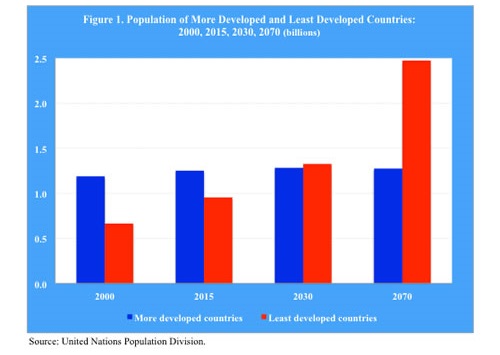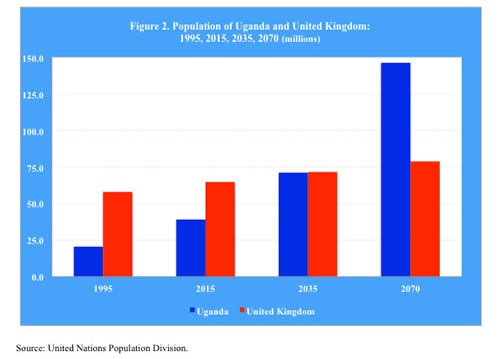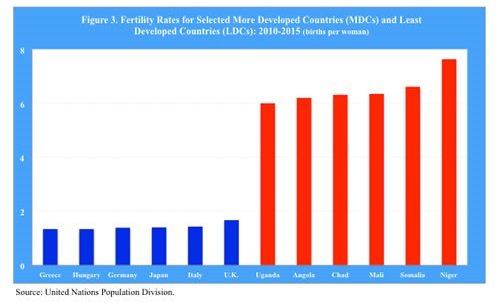|
UN sustainability goals should not overlook population growth centered in the poor, least developed countries

Developing population gap: Booming population of Uganda, top, is set to reach same level as that for the United Kingdom – though the UK's was three times larger than Uganda's in 1995
|
As world leaders convene for the UN Sustainable Development Summit in New York, to reflect on the progress of the Millennium Development Goals set in 2000 and adopt more goals for 2030, they ought to focus on the elephant in the room – a swelling global population that weighs on sustainability of social, economic and environmental development.
A swelling global population that has tripled since 1950, with a record high of 7.3 billion people, should not be overlooked in setting new international development goals.
According to the summit’s draft Declaration of the Sustainable Development Goals, the heads of state and government and high representatives resolve before 2030 “to end poverty and hunger everywhere; to combat inequalities within and among countries; to build peaceful, just and inclusive societies; to protect human rights and promote gender equality and the empowerment of women and girls; and to ensure the lasting protection of the planet and its natural resources.”
To achieve these lofty aims, the agenda includes a diverse set of topics, including 17 specific developmental goals and a broad range of 169 targets. Yet, population growth is not mentioned among the goals nor the targets.
Over the past 15 years, world population increased by 1.2 billion people and is now at a record high of 7.3 billion. During that time period, the population of the least developed countries grew nearly 10 times as fast as the more developed countries. The UN Population Division anticipates another billion by 2030 and at least 11 billion by the end of the century.
Today the average annual population increase of the least developed countries is 22 million compared to 3 million for the more developed countries. Also, whereas the combined populations of the least developed countries, about 954 million, represent 13 percent of the world’s population, they account for about 27 percent of the world’s annual population increase of about 84 million.
When the international community adopted the Millennium Development Goals in 2000, the population of the 47 more developed countries was about twice as large as that of the 48 least developed countries (see Figure 1). Due to the substantial differences in rates of demographic growth, the population of the least developed countries is expected to surpass the population of the more developed countries by 2030. Looking further ahead, the world’s least developed countries are projected to have twice the population size of the more developed countries by around 2070.
While the average annual rate of natural increase – births minus deaths - of the least developed countries is 2.5 percent, the rates among some of the poorest countries are in excess of 3 percent, which translates into a population doubling time of less than 25 years. Most of this growth is in Africa: The populations of Burundi, Chad, Niger, Somalia and Uganda, for example, are expected to double by 2040. The countries projected to increase at least fivefold by 2100 include Angola, Burundi, Democratic Republic of Congo, Malawi, Mali, Niger, Senegal, Somalia, Uganda, Tanzania and Zambia.

In contrast, the average annual rate of natural increase of the more developed countries is about one-10th of one percent. In addition, with the numbers of deaths outnumbering births, some 18 developed countries are experiencing negative rates of natural increase, including Germany, Greece, Hungary, Italy and Japan. Immigration is the only alternative to fertility for population growth. In the absence of sufficient compensating immigration, the populations of these aging countries as well as those of 20 others are projected to be markedly smaller by 2030.
A comparison of two countries with the same area, Uganda and the United Kingdom, illustrates the profound demographic changes underway. Several years before the Millennium Development Goals were adopted in 2000, the United Kingdom’s population was three times as large as Uganda’s. A few years after 2030, when the Sustainable Development Goals are scheduled for review, the populations of the two nations are expected to be the same size. Looking even further ahead, Uganda’s population is projected to be twice as large as the United Kingdom’s around 2075 (see Figure 2).

The underlying reason for the rapid rates of demographic growth among the least developed countries is high fertility rates. While the average number of births for the more developed countries is around 1.7 births per woman, the average for the least developed countries is 4.3 births per woman. Considerably higher fertility rates are observed in many of the least developed African countries, such as Niger with 7.6 births per woman; Somalia, 6.6; Mali, 6.4; Chad, 6.3; Angola, 6.2; and Uganda, 5.9 (Figure 3).
Many countries in various regions of the world have already passed through the demographic transition achieved by both low birth and death rates. At present nearly 80 countries, representing close to half of the world’s population, have fertility rates at or below the replacement level of about two children per woman. In contrast, about 21 countries, accounting for about 9 percent of the world’s population, have fertility rates of five or more births per woman.

Certainly lowering high rates of population growth to manageable levels is not a panacea ensuring sustainable development for the least development countries. However, reducing rapid rates of population growth will contribute substantially to the developmental efforts of those countries by making national goals easier and less costly to achieve.
Slower population growth rates will give those countries with more time to adjust to future population change. This in turn will strengthen their abilities to expand their economies, improve living conditions, educate youth, develop infrastructure and protect environments.
There is not a single issue among the sustainable development goals – including poverty, hunger, housing, education, employment, health, gender equality, human rights and environment – that would not benefit from reducing high rates of population growth. Lower rates of population growth among the least developed countries would also contribute to improving economic and employment prospects, while easing environmental stresses, thus reducing the pressures for young men and women to migrate to other countries to secure a decent standard of living.
Moreover, if fertility rates in the least developed countries were to decline faster than currently projected in the United Nations medium variant projection, the difference in population by the century’s close could be close to a billion people less, 2.2 billion versus 3.2 billion. Such a sizeable demographic difference would contribute to early stabilization of the world’s population.
As has been the case at previous global summits, world leaders will briskly walk into the UN General Assembly and deliver 10 minutes or so of largely forgettable prose. It would indeed be memorable if at least one leader recommended that the international community work together to address high rates of population growth.
In 15 years, the world population will have gained another 1.2 billion people and grow to 8.5 billion people. By then, nearly all of today’s political leaders will have either retired, been removed or passed away. Their replacements will address the UN Development Summit in 2030 – and by then, may find the courage to ask why rapid rates of population growth were repeatedly ignored for so long – and recommend that population growth be included in any future set of international development goals.
Rights: Copyright © 2015 YaleGlobal and the MacMillan Center
ABOUT THE AUTHOR
Joseph Chamie is an independent consulting demographer and a former director of the United Nations Population Division.
|
|Back to TITLE|
Page 1
Page 2
Page 3
Page 4
Page 5
Page 6
Page 7
Page 8
Page 9
Supplement 1
Supplement 2
Supplement 3
Supplement 4
Supplement 5
Supplement 6
PelicanWeb Home Page
|